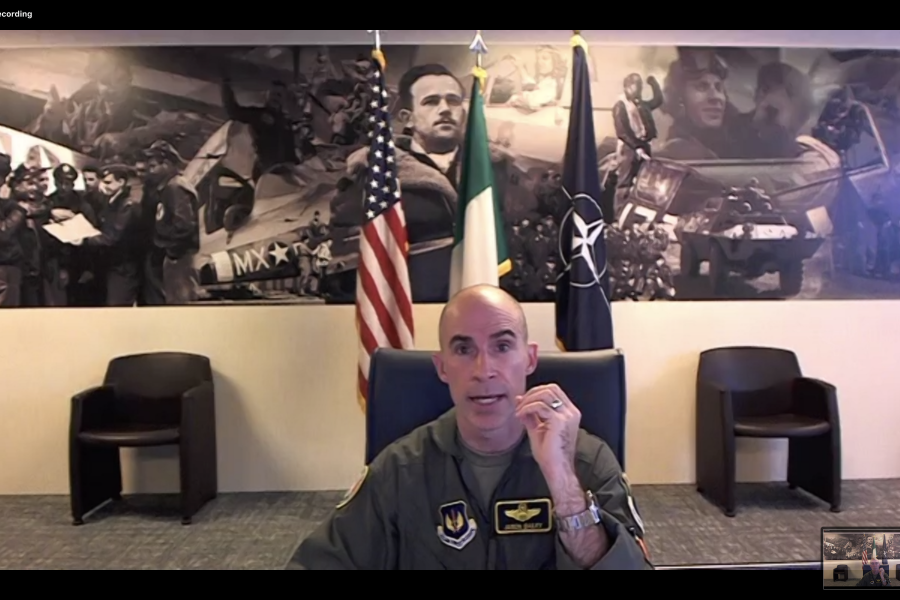The 31st Fighter Wing’s embrace of dynamic force employment—a type of concept of operations that emphasizes quick deployments and multirole Airmen—will transform various aspects of how Airmen based out of Aviano Air Base, Italy, do business, its commander said during a virtual all-call on Nov. 6.
31st Fighter Wing boss Brig. Gen. Jason E. Bailey—who assumed command on June 5—said quick-turn deployments like the ones the 555th Fighter Squadron recently carried out are “what the future looks like.”
“That ability, what was known and will be known for the future as dynamic force employment, that’s the kinda global capability that we need to train to, organize to, and it is different,” he said during the Zoom call. “It causes us to think about how we move stuff, how we move people, how we position warfighters in the right places, what capabilities go with, and how.”
This approach will frame how the wing prepares for future fights in other theaters, as well as how it approaches in-theater operations and the way its Airmen train on a daily basis, Bailey said.
This paradigm shift, however, doesn’t mean the wing will totally abandon more traditional deployments that involve “a pre-deployment preparation cycle,” shipping out, carrying out the mission, and recovering, he said, noting that multiple squadrons from the wing are currently on deployments that followed the more typical model.
Rather, he said, Airmen need to build the muscles necessary to do both to prepare for the operations of tomorrow.
Bailey promised that the wing would work to provide its Airmen “as much stability around that” as possible so as “to build in a surge capacity to be flexible.”
“The future of exercises is not the baseline … operational readiness inspection you’ve done in the past, where we just plan to dream up a scenario against a fictitious adversary, and then we train as if we’re gonna push forces forward, or how we might fight from some mythical base,” Bailey said. “We are forward postured. We are in multiple threat lanes. And we’re gonna think about that, and we’re gonna have the components of our organization who help feed us that information educate us, and we’re gonna adapt.”
According to Bailey, this adaptation includes considering new partnerships with “different bases,” assessing the way the wing moves and shifts within the U.S. European Command area of responsibility, and constructing “capability packages.” And these packages won’t be limited to maintainers and logistics Airmen, he noted.
“It goes across the entire wing,” he said.
The shift towards dynamic force employment also means an increasing focus on “multi-domain” operations, he said, noting that the wing’s communications squadron is working on boosting competitiveness “in the cyber domain.”
“We have to change everything from authorities to certain classifications and accesses to different types of teams, and the way that we organize within that comms squadron to posture for the future and what’s gonna happen,” Bailey said.
He also said that dynamic force employment will impact how the wing deters and dominates its competitors “across multiple domains and … levels of conflict,” and that the wing will still conduct operations in Africa.
During the same event, Bailey noted the wing will soon exercise closer to Russia, calling its recent activity in Bulgaria—which included a multilateral agile combat employment exercise and a subsequent stint backing up NATO’s enhanced Air Policing mission over the nation’s skies— “the tip of the iceberg” when it comes to heeding Chief of Staff Gen. Charles Q. Brown Jr.’s call to “accelerate change, or lose” with respect to allyship.
In addition to continuing collaboration with Bulgaria, Slovenia, and Croatia, Bailey said the wing will “also … move further outward” to include activity in Hungary and Romania.
This eastward movement is consistent with the kind of geographic refocus Defense Secretary Mark T. Esper recently told the Atlantic Council is necessary to more effectively deter Russia and reassure the nation’s partners and allies in Europe.
